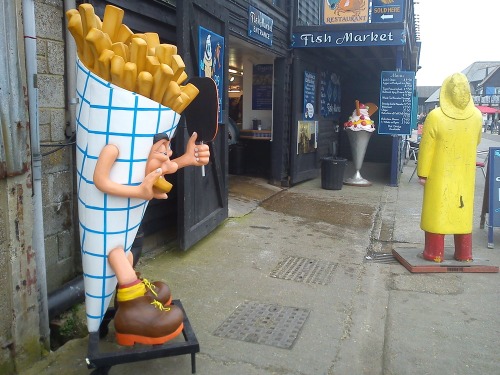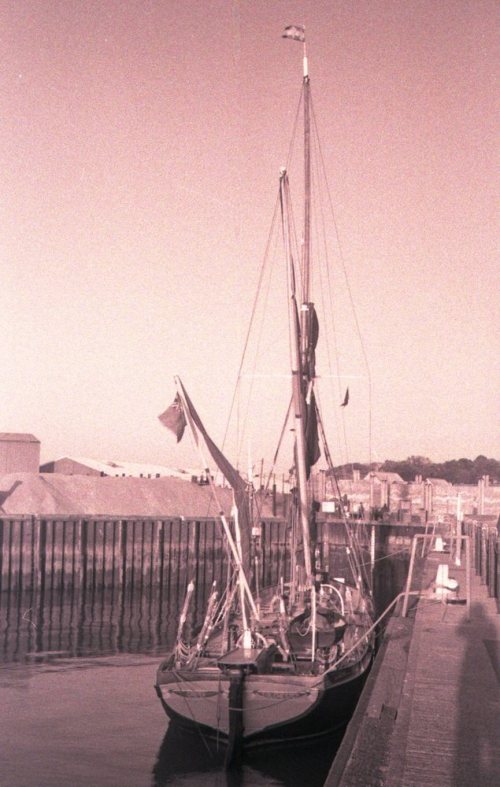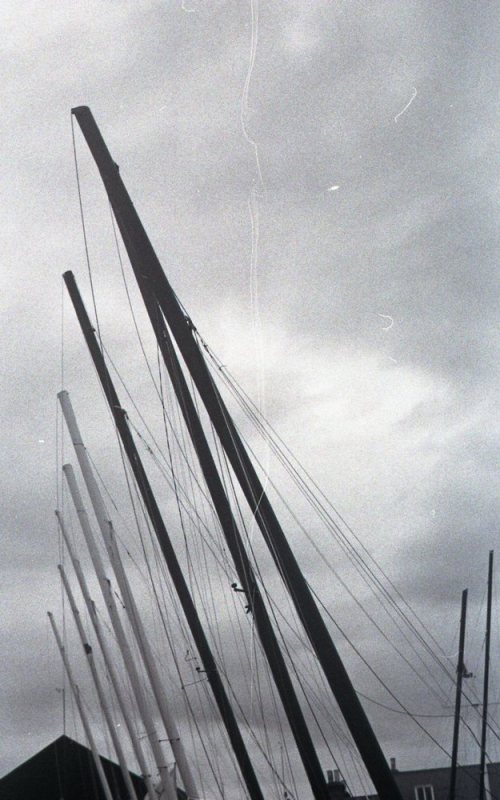New characters in Whitstable Harbour
The fish market has some new toys…
Image samples from slightly dodgy Canon EX Auto
So I’ve been using this old Canon EX Auto but it’s got a few issues.. here are some shots which really didn’t come out well:
Also, these ones from Flickr have a lot of banding in the sky:
My assumption is that it’s a sticky shutter, but tha banding above could be due to scanning artefacts, also someone has suggested light leaks which I hadn’t previously considered.
[edit: this is being discussed on Flickr here: www.flickr.com/groups/ishootfilm/discuss/72157629183564421]
In defence of HS1
I know this is going to be controversial but I LOVE the high speed train that runs from Faversham (and occasionally Broadstairs) into London St Pancras. I just can’t imagine ever going back to how my life was before it came. I commute daily from Whitstable to London for work, and I have been doing so for 13 years now. Before HS1, I would rarely get home before 8pm, more normally 8.30. Since HS1, I regularly get home before 7, and hardly ever any later than 7.45. HS1 has given me (at least) an hour per day of my life back, which is priceless.
Why am I saying this? It needs a bit of history to explain what’s going on. Bear with me, this might get a bit “trainspotter-ish” for a while.
The “standard” trains on this line run into London Victoria, and always have done. There are a few rush hour trains that go to Cannon Street via London Bridge for city workers as well. When HS1 came along, the Victoria services were degraded slightly to make more room – they stop at more intermediate stations, and thus take a bit longer. Understandably, a lot of people who do the Victoria commute are annoyed about this.
I share their annoyance, to a degree – in the years I’ve been commuting, there has been an increase of roughly 15-20 minutes journey time between Whitstable and Victoria. When I first moved down in the mid 1990s, it was around 1hr 15 minutes but It seems every other year another minute gets added to the journey time, whether as padding to improve reliability (Southeastern are fined for late trains), or, in this case, extra stops to account for a slight reduction in slow trains due to additional services elsewhere. These days you’re lucky to find a train that can do it in 1hr 30 min and they are often slower.
In contrast, the new High Speed trains don’t call at Whitstable, except a few in the rush hour (like the Cannon St ones), but you can change at Faversham and get to St Pancras from Whitstable with a total journey time of around 1hr 30 min even including the change. The few direct trains to and from Whitstable take only 1hr 15 minutes and there are three up in the morning, and three down in the evening.
The catch is: the St Pancras trains run on the new HS1 rail network for the last 20 minutes of the journey, from Ebbsfleet. This is a premium line, built for the Eurostar so that trains can run quickly into Paris and beyond through the Channel Tunnel. As a result, Southeastern charge a supplement for this part of the journey, which works out a few pounds more per trip than to Victoria. The extra supplement doesn’t sound like much, but on a daily commute it adds several hundred pounds to an already stupidly expensive annual season ticket, so most people choose to stick to the old Victoria service. To make it clear: the so-called “high speed” trains are not actually allowed to run faster on the normal rail network, only on this last section of new track.
There’s a further sting in the tail – Southeastern have been allowed to increase their fares by a significant amount above the national average for the last few years, in order to pay for the new infrastructure, which seems largely to have been focussed on the HS1 trains (this is asubjective, I don’t know what they spent the money on. But it’s the most obvious new shiny thing, so I assume that’s where the money went). So people feel, probably rightly so, that they’re paying more for the privilege of having their trains slowed down by the premium service.
The service has been running for almost exactly two years (almost to the day), and it seems that anger amongst the Victoria commuters has reached a head, with Thanet MP Roger Gale stating that the service is of “no use at all to those travelling from the whole of East Kent particularly along the Kent coastline”
Sorry Roger, you’re wrong, And here’s why:
If you work near Victoria, clearly you want to go into Victoria. Your journey now takes a bit longer, you will be annoyed. But, not that many people work within walking distance of Victoria, so this is not the majority of commuters. Most of us work elsewhere, so a tube journey is required, whichever major London staton we arrive at. St Pancras actually has better tube connections than Victoria, as well as Thameslink (for what it’s worth!) so in terms of time, there’s either a small improvement, or no substantial difference for the majority of commuters. The St Pancras line also offers the extra choice of stopping at Stratford, with good connections into Canary Wharf, which are not available on the Victoria route. If you work in the City, you’re already using the Cannon St service which hasn’t been greatly affected by the change, as far as I can tell. For these reasons, the additional St Pancras trains are a significant benefit to those of us living in East Kent. We now have far more options than we used to, and many more trains into London in total.
The only issue I can see is that the St Pancras journey costs more. This is what has to be addressed. You can rant, and rail about slower services all you like, but the High Speed service is a good one, it’s more reliable, especially in the Winter, and the principal reason that people still use the slower services is because they don’t cost more. The problem is not the High Speed trains, they really do improve the train service from East Kent substantially. the problem is, as usual, all about money.
So, how to solve this: Southeastern can’t run trains on HS1 without paying more money to the people who own the network. They also did make a substantial investment in buying these new trains. That money has to come from somewhere. So, either prices go up across the whole network to pay for it, or they charge a supplement.
The trouble is that they seem to have done both – put prices up across the network *and* charged a supplement. In my mind, the supplement is justifiable from Ashford, where people get a vastly improved service with journey times into London not much over 30 minutes now, but it’s barely justifiable for the Faversham line, where the High Speed is only quicker because they slowed down the existing services.
I think Southeastern should look again at the supplement for people commuting from the East Kent coast. They could reduce the season ticket price for those of us coming from the Medway towns and further out, without losing the premium of people starting their journey at Ebbsfleet. This way, people could pay the same price for a ticket that worked on either HS1 or Victoria lines, and make their choice based on the bit of London they want to get to, rather than on cost. From my experience, a substantial number of people using HS1 actually get on at Ebbsfleet, so as long as they retain the supplement from there, they won’t lose a lot of money – and, after all, these season ticket holders have already paid a premium through fare increases.
Perhaps what Roger Gale might want to look at is brokering an agreement with Southeastern on HS1 pricing for East Kent tickets, rather than throwing the baby out with the bath water.
HS1 is great, it’s a massive benefit to everyone in Kent. Don’t destroy it, work with it, make it better.
Shadow pattern in stairwell at work today
Someone else’s exposed film!
A 120 reel of Kodak Ektachrome 400 slide film, already exposed. Found in a second hand Bencini Koroll II camera I bought off eBay…
Suggestions as to what to do with it are welcome!
If no-one has a better idea I’ll run it through some black-and-white developer (APH09 1:100 1hr stand, I guess..)
I’m a bit reluctant to give/send it to a lab as I have no idea what’s on it!!
(faint) double rainbow over Bloomsbury
It’s good that we still use the names of great people for great things…
It worked! My first home-developed film…
So, I’ve got some water streaks, especially towards the bottom of the film where it was hanging (these might rinse out if I could be bothered to put it back through some Photoflo solution) and a few random development artefacts but on the whole I think this is a real success! The random colours are what the scanner decided they should be – I like them that way so I left it – these are unprocessed 1200dpi scans straight off the Epson V500 using Epson’s scanning software.
I’m really pleased with the Yashica too – it was well worth the effort of fixing it, and maybe worth a bit more of my time to get it working more reliably.
I’ll put higher resolution scans of the best ones up on Flickr later in the week when I’ve got more time – right now it’s way past my bedtime (plus I think Lynne will kill me if I wake her up with the scanner again) and I have to go to work in the morning!
For reference here’s the recipe I used, a hybrid of many different ones I found on the web. The film is supposedly Ferrania 200 (I guess Solaris), rebadged as “Capital Plus”, but in theory all C41 films have the same development time as long as you shoot them at the speed on the box so this should be pretty generic:
- Presoak in water (3 mins warm 35°C, 2 mins 20°C)
- Develop 1:50 APH 09 (6ml in 300ml) for 15 mins at 20°C. Agitate 15 times slowly to start (30 seconds) then 3 times every minute by slow inversion not twisting
- Stop with 5 water rinses and agitation
- Fix (Ilford Rapid Fixer 1:4) for 5 mins (agitate for 30 seconds then at intervals, not critical)
- Rinse many times with running water, for at least 10 minutes.
- Final rinse use a few drops of photoflo (wetting agent)
- 2 hours drying time, hanging in the bathroom
Developing C41 film in Adox Adolux APH 09 (Rodinal)
If you know anything about film developing you might be confused by the title of this post – C41 film is the standard colour negative film most people are used to (stuff like Kodak Gold, for example), while Rodinal is a classic (very old formula) black-and-white film developing fluid.
So, why do this? Furthermore, why on earth did I choose this as my first ever attempt at self-developing a film?!
I’ve been getting into film photography for the last couple of months. I think I’ve run out of steam with my digital stuff for the moment – I’m sure I’ll go back to it soon and I still rely on it for anything “important”, but I seem to have stagnated in terms of subject matter and style – I can’t see anything different in my pictures from this year than last year, or the year before. So, I’ve bought a random selection of very cheap film cameras from eBay and I’ve been putting various random films through them, with substantially varying results! I’ve also bought a big box of ultra-cheap C41 film (re-badged Ferrania 200), mainly so I can test out all these cameras without wasting too much money.
Getting C41 film processsed is still surprisingly easy and cheap, even in this digital age – my local Tesco Extra does development (process-only) in under an hour for less than £1, and corner shops like Kodak Express and Snappy Snaps will do it quickly enough, although they charge a bit more. However, none of these places will process black-and-white film on the premises, they all send it off. That means it takes longer, and in most cases costs more. For this reason, I’ve been thinking for the last few weeks about learning to develop my own black and white film – lots of people seem to do it with great success, and it gives you a lot more control over the whole process.
My plans have been brought forward by the fact I managed to completely snap a film inside one of these old cameras – a Yashica Minister II that has definitely seen better days. Although I’ve mostly managed to get it working (including clearing lots of bits of broken glass from inside the rangefinder!) it’s still a bit flakey and the rewind sticks sometimes. So, when it stopped mid-rewind I gave it a bit of extra pressure. It turns out that the gearing ratio must be tremendous as I’d actually reached the end of the film, and the extra pressure tore the film down the middle!
This left me with a quandary – I couldn’t wind the film back into the canister as it had snapped near the end of the film, so there was no way to even get it out of the camera without exposing the whole lot, losing all the pictures, let alone get it to a development shop. Around the same time, almost purely by chance I came across the Colour Films Developed In B/W Chemicals group on Flickr, which gave me my answer. After an awful lot of research on the web, I decided that Rodinal (or a Rodinal-based developer) was the way I wanted to go for black and white, and it seemed to be fine for the occasional C41 development too. Of course, developing C41 in Rodinal gives you black-and-white negatives, not colour.. except that occasionally Rodinal does develop a tiny bit of some of the colour as well, so we’ll see what happens.
This has all happened quickly – I broke the film on friday night (trying to finish it up so I could take it in for development on Saturday). On Sunday I ordered all the chemicals and equipment, which arrived today (Tuesday), and this evening I’ve developed my first film!
I’m writing this as the negatives are drying – so far it looks like the development has worked a treat – the pictures look clear and sharp to the naked eye, which is doubly good news as it means the Yashica is working well, otherwise they’d be wrongly exposed. But, the final proof will be once I get them on to the scanner. Watch this space!





















